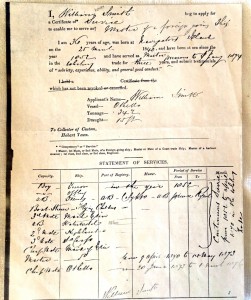William SMITH is my great great grandfather but from his application for a Master Mariners certificate he was born in the Navigator Islands in 1840. Therefore he should have a Samoan sounding name.
Here is a scan of Master Mariner PDF to see it enlarged.
I have also seen it mentioned in a book which is a secondary source 1
Captain William Smith arrived in Tasmania in an open boat (from who knows where) and sailed up the Derwent into the waiting arms of officialdom. He was accepted and given the name “Smith”.
I am going through the Marine Board shipping log records at the moment trying to find when he first had his name changed to William SMITH. But I am stuck on the boat name between Offley and Calypso in the certificate above. They are all whaling boats so far always in and out of Hobart.
Shipping logs are a great primary source as it is filled in when a sailor agrees to serve on board a ship. Information included is:
- Signatures of each crew member – both Christian and Surname in full
- Age when signing agreement
- Place of birth – can be any of these city/town/country/state
- Ship in which he last served and port the ship belonged to
- Place and date of discharge from that ship
- Place and date of entry onto this ship
- In what capacity they will serve
- Time when he should be on board – usually at once or a date given
- Wages per month or voyage
- Lay – black oil, sperm oil, whalebone
- Amount of wages advanced
- Amount of monthly allotment
Readers: Can anyone using the PDF work out a possible boat name for me?
- Poulson, Bruce. Recherche Bay: A Short History. Southport Tas. Southport Community Centre, 2004. Print. ↩


